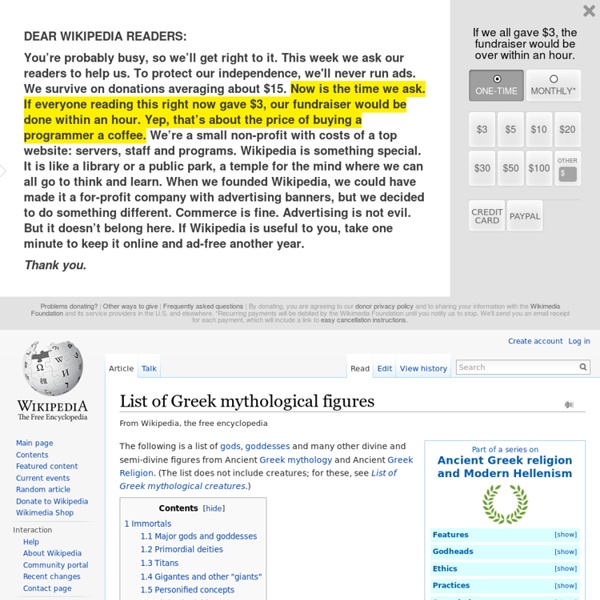Bellerophon, hero known for defeating Chimera - Greek Gods
Bellerophon was a famous Greek hero, mostly known for defeating Chimera, a fire-breathing mythical monster. He was also recognised by riding white Pegasus which was a sort of a gift from Athena for his devotion to the goddess. Bellerophon was, according to Homer's Iliad, a son of Glaucus and Eurymede of Corinth.
Cronus
Ruler of the Titans in Ancient Greek mythology Mythology[edit] Only Cronus was willing to do the deed, so Gaia gave him the sickle and placed him in ambush.[4] When Uranus met with Gaia, Cronus attacked him with the sickle, castrating him and casting his testicles into the sea. From the blood that spilled out from Uranus and fell upon the earth, the Gigantes, Erinyes, and Meliae were produced.
Bellerophon
Etymology[edit] One possible etymology that has been suggested is: Βελλεροφόντης from βέλεμνον, βελόνη, βέλος ("projectile, dart, javelin, needle, arrow, bullet") and -φόντης ("slayer") from φονεύω ("to slay"). However, Geoffrey Kirk says that "Βελλεροφόντης means 'slayer of Belleros'".[3] Belleros could have been a Lycian, a local daimon or a Corinthian nobleman—Bellerophon's name "clearly invited all sorts of speculation".[3] Family[edit] Mythology[edit]
Saturn
Sixth planet from the Sun in the Solar System Physical characteristics Composite image comparing the sizes of Saturn and Earth Saturn is a gas giant because it is predominantly composed of hydrogen and helium. It lacks a definite surface, though it may have a solid core.[23] Saturn's rotation causes it to have the shape of an oblate spheroid; that is, it is flattened at the poles and bulges at its equator. Its equatorial and polar radii differ by almost 10%: 60,268 km versus 54,364 km.[5] Jupiter, Uranus, and Neptune, the other giant planets in the Solar System, are also oblate but to a lesser extent.
Glaucus
In Greek mythology, Glaucus (; Ancient Greek: Γλαῦκος, Glaûkos meaning "glimmering") was a Greek prophetic sea-god, born mortal and turned immortal upon eating a magical herb. It was believed that he came to the rescue of sailors and fishermen in storms, having earlier earned a living from the sea himself. Family[edit] Mythology[edit] Origin[edit]
Rhea
From Wikipedia, the free encyclopedia Jump to navigationJump to search Rhea may refer to:
Zeus Heaven: Proteus and Bellerophon
Official walkthrough written by Impressions Games » Episode 1: Boys will be Boys (Lycia) Goals: -Population of 1500 -Support 16 Hoplites or Better -Treasury of 1500 Hints & Tips This is quite a large area so don't worry too much about planning in advance.
Ops
Ancient Roman goddess of fertility and the earth In ancient Roman religion, Ops or Opis (Latin: "Plenty") was a fertility deity and earth goddess of Sabine origin. Iconography[edit] Name[edit] The Latin word ops means "riches, goods, abundance, gifts, munificence, plenty".[2] The word is also related to opus, which means "work", particularly in the sense of "working the earth, ploughing, sowing".
Proteus
Illustration of Proteus by Andrea Alciato from The Book of Emblems (1531) In Greek mythology, Proteus (;[1] Ancient Greek: Πρωτεύς, Prōteus) is an early prophetic sea-god or god of rivers and oceanic bodies of water, one of several deities whom Homer calls the "Old Man of the Sea" (halios gerôn).[2] Some who ascribe a specific domain to Proteus call him the god of "elusive sea change", which suggests the constantly changing nature of the sea or the liquid quality of water. He can foretell the future, but, in a mytheme familiar to several cultures, will change his shape to avoid doing so; he answers only to those who are capable of capturing him. From this feature of Proteus comes the adjective protean, meaning "versatile", "mutable", or "capable of assuming many forms". "Protean" has positive connotations of flexibility, versatility and adaptability. Name Origin[edit]
De Astronomica
De Astronomica, also known as Poeticon Astronomicon,[1] is a book of stories whose text is attributed to "Hyginus", though the true authorship is disputed. During the Renaissance, the work was attributed to the Roman historian Gaius Julius Hyginus who lived during the 1st century BC. However, the fact that the book lists most of the constellations north of the ecliptic in the same order as Ptolemy's Almagest (written in the 2nd century) has led many to believe that a more recent Hyginus or Pseudo-Hyginus created the text. The text describes 47 of the 48 Ptolemaic constellations, centering primarily on the Greek and Roman mythology surrounding the constellations, though there is some discussion of the relative positions of stars.
proteus bellerophon stellvia
MoreEven more from Google Sign in All Images Videos



